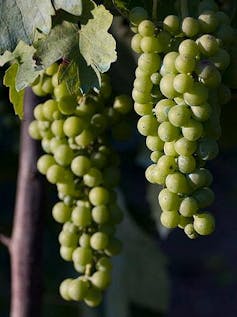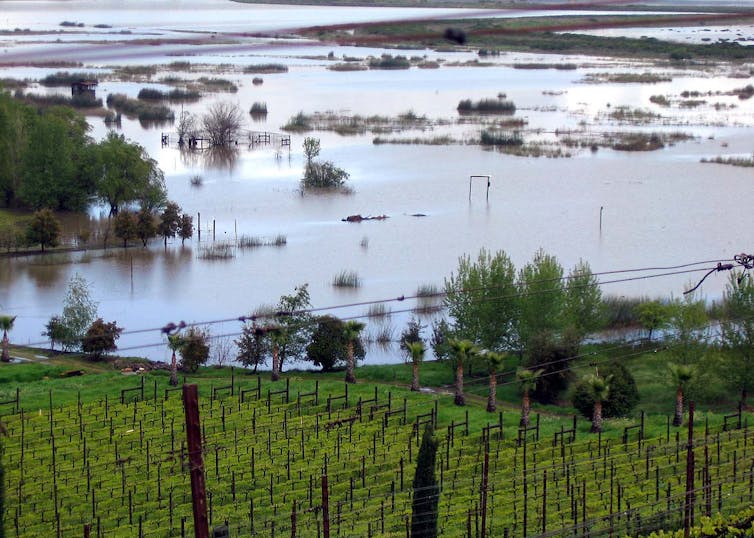As the climate gets warmer, growing conditions and ripening times of crops will be affected. This raises all kinds of challenges for food security, but as we hit the festive season you may also be wondering what it will do to your wine.
In the Northern Hemisphere, researchers have analysed historical records of the start dates of winegrape harvests in Burgundy, France. They have found that in warmer years and periods winegrapes tend to ripen earlier in the harvest season.
In Australia this trend to earlier winegrape vintages has also been detected. A recent continent-wide study assessed the vintage records from 44 vineyards across 12 Australian winegrowing regions, with one case stretching back for 115 years and several others for over 50 years. The study found a trend to earlier maturity of winegrapes through time in 43 of the 44 vineyard blocks. These changes are associated with warming trends in the respective regions.
Earlier maturity of winegrapes is, in many cases, not desirable. The quality of the product, which is strongly influenced by the temperature of the ripening period, can be adversely affected. Higher ripening-temperatures increase the rate of sugar development and speed-up acid degradation. They are also associated with altered flavours and aromas. This can change the over-all wine balance, and may have contributed to a recent trend to increasing alcohol concentrations in wine.

For many red wine styles, colour is an important indicator of quality. In general, winegrapes produced in warmer climates have lower concentrations of red colour compounds compared with grapes grown in cooler climates. In some growing regions and seasons where temperatures are currently sub-optimal for red wine production, growing-potential may increase with warming.
In the future, with more warming projected, continuation of trends to earlier harvests are anticipated for most Australian winegrowing regions. Modelling studies indicate that the quality of winegrapes will be reduced unless adaptive measures are implemented.
Shifts in climate extremes, rather than in mean temperature and rainfall, may have more impact on grape-growers’ coping ability, at least in the short-term. Heatwaves have been affecting grape-growers in southeast Australia with increasing frequency. For example, a 15 day “hot spell” (above 35°C) in South Australia during the harvest period in March 2008 affected winegrape quality and resulted in a problematic fermentation process. In addition, many ripe grapes couldn’t be processed in a timely manner by wineries which were already at full-capacity. Significant heat-stress related crop losses were also reported at many sites during an exceptional heatwave that occurred in south-eastern Australia in the summer of 2009.
For winegrape growers, extreme rainfall - projected to increase in frequency as a result of climate change - can cause flood and erosion damage, berry-splitting and berry-drop. Fungal diseases develop in wet and humid conditions, and can devastate winegrape crops close to and during harvest.
Much of south-eastern Australia experienced very wet conditions in October 2010 and February 2011. These conditions were associated with the 2010 La Niña and also very high sea surface temperatures around northern Australia at this time. During these periods many vineyards were exposed to very much above average rainfall.

These events led to increased incidences of disease in vineyards across south-eastern Australia, as well as inundation of some lower-lying vineyards. Growers also reported difficulty in accessing fungicides, and impacts to transport and logistics. If these kinds of events increase, as projected, over-all costs of producing winegrapes will increase.
Of course there are adaptation options that could reduce these impacts in the winegrape sector. Some regions are adopting management practices that increase the resilience of the crop to the current extreme conditions. Practices include reducing exposure of fruit on west-facing canopies to reduce the impact of extreme heat, for example.
Over the longer term, growers can change varieties to better fit with the warmer projected climate. Some “hotter-adapted” varieties, such as Vermintino and Fiano (whites) and Sagrantino and Nero d'Avola (reds), are already being trialled and introduced. Planting the right varieties will help grapes ripen at a time when they have the best chance of retaining their quality.
If adaptive measures are implemented, grape-growing suitability may improve in current cooler regions like Tasmania and southern Victoria as options to introduce different varieties of winegrapes broaden. Potential also exists for development of cooler or more elevated sites within some regions, and/or expansion to new regions, with some growers already making these moves to avoid threats from the changing climate.

